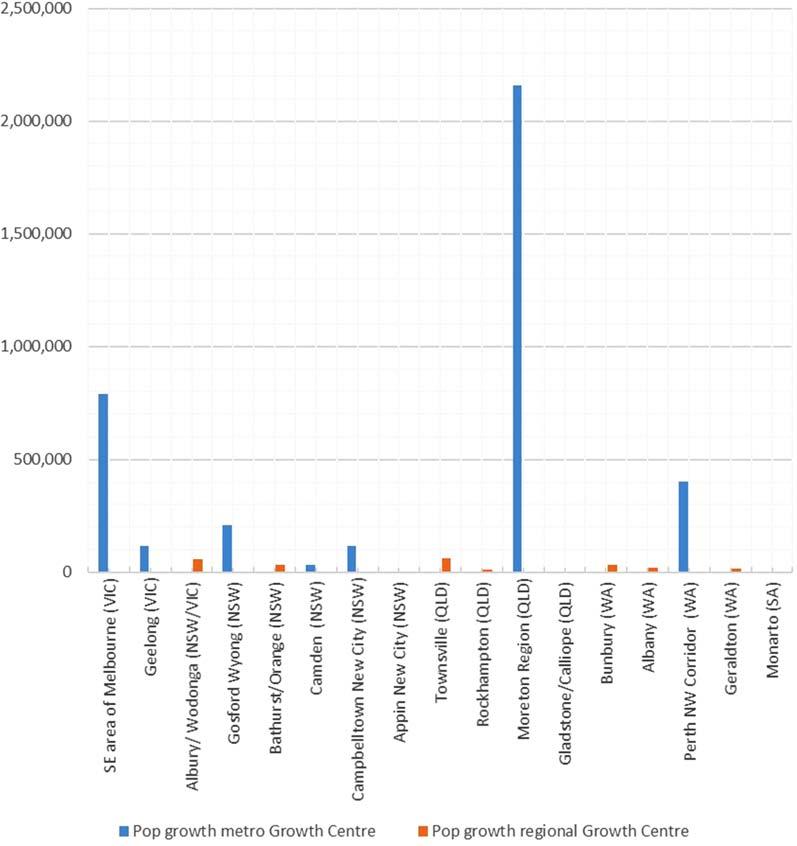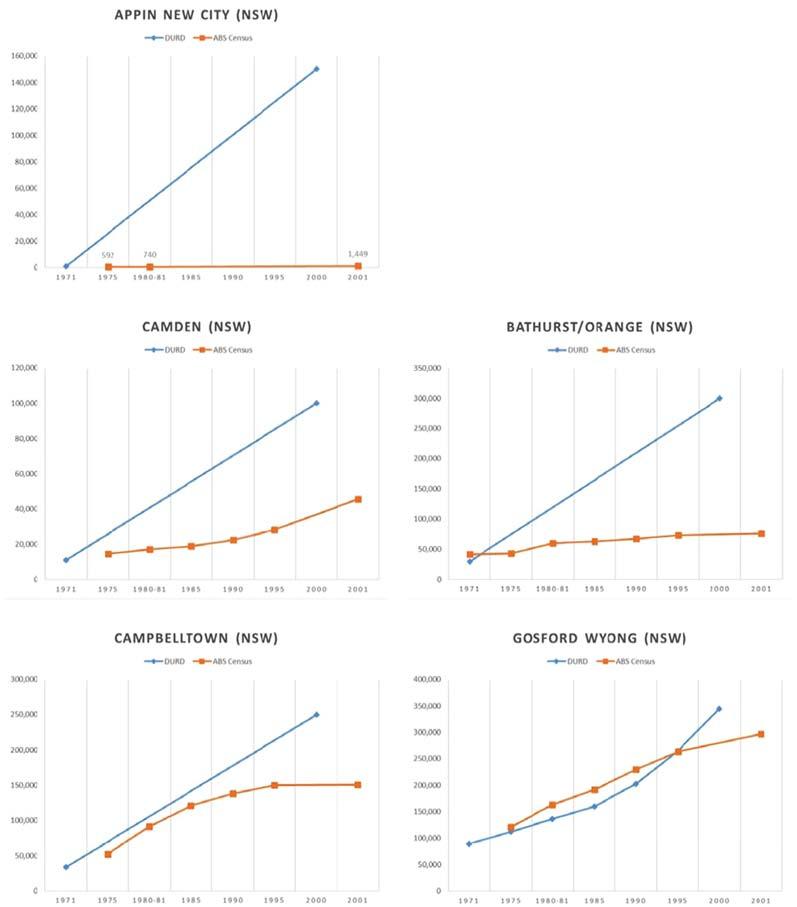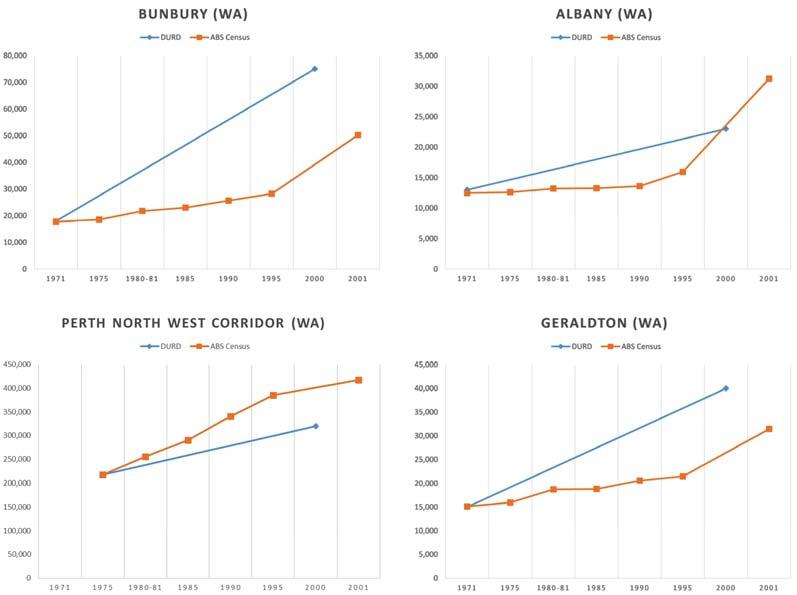
ISSN: (Print) (Online) Journal homepage: https://www.tandfonline.com/loi/rppe20


ISSN: (Print) (Online) Journal homepage: https://www.tandfonline.com/loi/rppe20
Julian Bolleter, Robert Freestone, Robert Cameron, George Wilkinson & Paula Hooper
To cite this article: Julian Bolleter, Robert Freestone, Robert Cameron, George Wilkinson & Paula Hooper (2021): Revisiting the Australian Government’s Growth Centres program 1972–1975, Planning Perspectives, DOI: 10.1080/02665433.2021.1885479
To link to this article: https://doi.org/10.1080/02665433.2021.1885479

Published online: 23 Feb 2021.

Submit your article to this journal


Article views: 11


View related articles

View Crossmark data

Full Terms & Conditions of access and use can be found at https://www.tandfonline.com/action/journalInformation?journalCode=rppe20

PLANNINGPERSPECTIVES
https://doi.org/10.1080/02665433.2021.1885479
JulianBolleter a,RobertFreestone b,RobertCamerona,GeorgeWilkinsona and PaulaHoopera
aAustralianUrbanDesignResearchCentre,UniversityofWesternAustralia,Perth,Australia; bSchoolofBuiltEnvironment, UniversityofNewSouthWales,Sydney,Australia
ABSTRACT
From1973to1975anewAustralianGovernmentledbyGoughWhitlam activelypursuedplanstodevelopregionalandsub-metropolitanGrowth Centreswithsignificantlyboostedpopulationsfollowinganationalstrategy publishedinJune1973whichmappedanationalcoverageofprospective locations.Theintentionwasforthesecentrestoalleviatepressureonthe capitalcitiesconsideredovercrowdedanddeterioratinginefficiencyand qualityoflife.ThecontroversialdismissaloftheWhitlamGovernmentin 1975signalledthewindingbackandeffectivedemiseoftheprogramme. Thispaperexaminesthepopulationprojectionsforthecentresunderofficial considerationto2000andtheiractualgrowth.Despitethecriticisms attachedtothisprogramme,severalcentrescameclosetoachievingtheir populationtargetsfor2000.Moreover,ifFederalGovernmentsupporthad beensustained,moremayhaveexceededtheirprojections.Theimplications foraresurgentnationalsettlementpolicyareconsidered.
Introduction
KEYWORDS
Newcities;Decentralization; GrowthCentres;Gough Whitlam
Inthe firsthalfofthe1970stherewereseriousmovesinAustraliatoembarkonalarge-scaleprocessof newcitybuilding.Initially,undertheLiberal-CountryParty(conservative)governmentheadedby PrimeMinisterWilliamMcMahon(1971–72)andsubsequentlyandmorevigorouslyunderaLabor administration(leftofcentre)ledbyGoughWhitlam(1972–75),anationalGrowthCentreprogramme evolved.Againstabackdropofenduringinterestinthenewtownideainternationally1,thesemoves weretheculminationofgrowingprofessionalandpopularconcernsdevelopingthroughthe1960s thattheAustralianurbanpopulationwastooimbalanced.Themajorproblemswerethebigcoastal cities,particularlySydneyandMelbourne,whilepurposefulregionaldevelopmentlanguished.
Thedesireddecentralizationofpopulationandindustrywasalongstandingthemeofnationaldevelopmentthinking.However,onecriticaljuncturefromthelate1960swastolinkthistomoreselective programmesfocusedonexpandedandnewregionalcentresratherthanineffectuallydispersingincentivesacrossmanyruralcentres.Thequestionofanoptimumcitysizewasdebated.Theotherdecisive changeinthinkingwastoelevatetheseconcernstothefederallevelratherthandebatethemwithinthe contextoftheultimatelycompetitivepoliciesofsixseparatestategovernments.
CONTACT JulianBolleter julian.bolleter@uwa.edu.au
1PeiserandForsyth, NewTownsfortheTwenty-FirstCentury.
©2021InformaUKLimited,tradingasTaylor&FrancisGroup
LaborPrimeMinisterWhitlamwaselectedtoofficeonaplatformwhichelevatedurbanissuesto nationalprominence,anunprecedentedbreakthroughinAustraliannationalpolitics.Hisconservative predecessorMcMahonhadbelatedlypickeduptheirappealinbothurbanandruralelectoratesaheadof thenationalelectioninNovember1972andestablishedafederalauthoritytodevelopanewcitiesprogramme.Laboruponwinningofficeworkedwiththisinstitutionalinitiativebutembeddeditwithina muchlargerbureaucraticstructuredevotedtoaraftofurbanandregionaldevelopmentpolicies.Aspirationsatatimeofacceleratingmetropolitangrowthandtheentrenchingofsocio-spatialinequalities werehigh.2 Whilenewpatternsofmetropolitanandregionalgrowthensued,thepromiseofafundamentallyrestructuredapproachtonationalurbandevelopmentwasnotdelivered.Somecommentators acknowledgeredeemingreformsbutalastingsenseoffailureattachestothelegacyoftheGrowthCentre programme. 3 Soweretheoriginalprojectionsandexpectationscompletelydivorcedfromreality?
Thispaperrevisitsthe1970sGrowthCentreprogrammeprimarilythroughre-investigatingthe selectionofcentres,thespecificationofpopulationgrowthtargets,andtheextenttowhichthese wereachievedthroughcontemporaryandlaterdevelopment.Whilethegrowthcentresofthis erahavenotbeenneglectedinplanninghistory4,therehasbeenlittleretrospectivedemographic analysistounderstandthedegreetowhichactualgrowthrelatedtotheoriginalpopulationtargets. TheoneexceptionisLloydandAnderton5 whoexaminedthepercentagepopulationgrowthofthe centresusing1981and1986censusdata.Theirsisaprogenitorofthispaperwhichconsiders growthprojectionsfor2000againsttheachievedpopulationsforthecensusyear2001.Thecentral researchquestion,whichguidesourenquiry,is:towhatextentdidtheWhitlamGovernment’ s nominatedGrowthCentresachievetheirpopulationprojectionsfortheyear2000?Attempting toansweritprovidesinsightsintotheoriginsofandthereceptiontotheprogramme.
Thepaperisstructuredinthefollowingmanner.Theinitialbackgroundsectionsetsouttheinstitutional settinginwhichtheGrowthCentresprogrammewas conceivedandthenweexplorethemaindrivers behindthepolicy fixwhichemerged.ItalsoprovidesanoverviewoftheGrowthCentresprogramme, howtheGrowthCentreswereselected,andhowtheirpopulationprojectionswerecalculated.Inthe methodssection,wesetoutthequantitativetechniquesusedtoevaluatethesuccessorotherwiseofthe GrowthCentresinmeetingtheirpopulationtargets.ThesubsequentdiscussionsectionconsiderswhatfactorslaybehindtheunevenresultsandreflectsonpopulationchangeintheGrowthCentrestudyareasfrom 1973to2001.Wesoughttounderstandwhetherthereisarelationshipbetweenpopulationgrowthandsome ofthekeyvariableswhichtheCitiesCommissionproposedshouldinformcentreselection.6 Theseinclude thesizeoftheexistingpopulation,proximitytoacapitalcityorthecoast,availableinfrastructure,employmentopportunities,andwhethertheGrowthCentrehadthesupportoftherespectivestategovernment.The paperconcludeswithbriefreflectionsonthecontemporarypromotionofaNationalSettlementStrategy.
Background
Establishingafederalframeworkfornewcities
InlateOctober1972,immediatelybeforeanationalelection,theMcMahonGovernmentestablishedaNationalUrbanandRegionalDevelopmentAuthority(NURDA)forAustralia.Itsmain
2Loganetal., UrbanandRegionalAustralia
3Orchard, WhitlamandtheCities,PhillipsandTurner, “TheFailureoftheNewCitiesProgramme” 4Painter, “Urbangovernment,UrbanPoliticsandtheFabricationofUrbanIssues”;Orchard, “ShiftingVisionsinNationalUrbanand RegionalPolicy2”.Forexamplesee:Painter, “UrbanGovernment,UrbanPoliticsandtheFabricationofUrbanIssues”.;Orchard, “ShiftingVisionsinNationalUrbanandRegionalPolicy2” 5LloydandAnderton, “FromGrowthCentrestoGrowthCentres?” 6CitiesCommission, ReporttotheAustralianGovernment.
rolewastoadvisethegovernmenton ‘mattersrelatingtourbanorregionaldevelopment.’ While notformallyspecifiedinfederallegislation,theintentwastoworkwithstategovernmentstoidentifyregionalandsub-metropolitanplacesasnationalGrowthCentres.HeadingtheauthoritywasSir JohnOverall,therecentlyretiredchiefoftheNationalCapitalDevelopmentCommission(NCDC) whichhadplannedanddevelopedthenationalcapitalofCanberraintoAustralia’slargestinland citysince1958.ThedeputycommissionerwasRobertLansdownwhohadalsocomefromthe NCDC.ThedefactocommitmenttoaCanberramodelofmodernistgardencityplanningfor decentralizedurbandevelopmentwasclear,andLansdown7 hadalreadylaudeditasanexemplar. ThemajortaskofNURDAwastoprepareareportonCommonwealthparticipationinanational five-yearprogrammeofurbanandregionaldevelopmentbyJune1973.
FollowingtheelectionoftheAustralianLaborPartytogovernmenton2December1972,the pledgedDepartmentofUrbanandRegionalDevelopment(DURD)wascreatedtocarryoutthe Government’surbanagenda.NURDAwasre-formedastheCitiesCommission.TheWhitlam GovernmentdecidedthattheCitiesCommissionshouldrealizeNURDA’sstatutoryresponsibility andadvisetheGovernmentonaprogrammeofAustralianGovernmentsupportforregionaland metropolitangrowthcentres.8 TheCommissionwasasmallmulti-disciplinaryorganizationof engineers,townplanners,economists,geographers,sociologists,andotherprofessionals.9 Within thenewfederalministryunderthepoliticalleadershipofTomUren,theCitiesCommissionwasto actasa ‘professionalconsultant’ totheDURDinphysicalplanningexerciseswithspecialreference totheestablishmentofnewcitiesandassistingintheirearlystagesofdevelopment.10
TherelationshipbetweenDURDwithitssweepingagendaofsocialandeconomicreformand thephysicalistapproachoftheCitiesCommissionsteepedinNCDCculturewasnotalways smooth.Eventually,UrenintroducedintoParliamenttheCitiesCommission(Repeal)Billwhich wastoreplaceitwithaBureauofCitieswithinDURD.TheActwasassentedtoon11November 1975justbeforethedismissaloftheWhitlamGovernment.Thelattereventwasatumultuoustime inAustralianpoliticalhistory.11 ThecollateraldamagewastheendoftheDURDexperiment,and withit,anysustainedfederalcommitmenttogrowthcentresastheLiberalsreturnedtoofficeunder MalcolmFraser.
DURD’spolicytargetswerevaried:urbanlandreform,addressingservicebacklogs-inparticularsewerageprovisioninoutermetropolitansuburbs-upgradingsocialinfrastructure,rehabilitationofoldinner-cityhousing,urbanconservation,andenhancementoftheroleoflocal government.Manycentredontheprincipleofregionalismwithinthecapitalcities-theideaof lesseningdevelopmentpressuresonCentralBusinessDistricts,andtoencouragemorecoherent andbetterservicedurbandevelopmentinouterareasdrivenbynotionsofspatialjustice.12
Toinsiders,DURD’sprogrammesrepresentedinnovativeandtimelycentralizedinterventions intheprocessesofAustraliancitydevelopmentunderpinnedbyacommitmenttosocialdemocraticreform.13 Toitscritics,whichinduecoursebecamelargerinnumberasneoliberalism becametheprevailingpoliticalorthodoxyfromthe1980s,DURDwasabig-spendingideological upstartunresponsivetolocalismandadministrativeconvention.PainterdamnedDURDas ‘ pretentious’ ,a ‘wasteofexpenditure,’ andalethalcombinationof ‘ideologicalandtechnocratic
7Lansdown, “Canberra:AnExemplarforManyDecentralisedAustralianCities” 8Neilson, “TheNewCitiesProgramme” 9CitiesCommission, FirstannualreportNovember1972-June1973 10Ibid.
11KellyandBramston, TheDismissal:IntheQueen’sname
12Orchard, “ShiftingVisionsinNationalUrbanandRegionalPolicy2” . 13LloydandTroy, InnovationandReaction.
zealousness.’14 PhilDay,himselfastategovernmentbureaucrat,arguedthatDURDwasdeplorably ill-conceived’ :
Youcannotadministerathreemillionsquaremilecontinentbyremotecontrolfromtheincestuous isolationofCanberra.Yourchancesareevenlessif,ontotheproliferatingbureaucraticbandwagon, youallowtoclimbaspendthriftarrayofdoctrinairetheorists,trendybutinexperiencedenthusiasts, arrogantpower-seekers,andassortedpartyhangers-on.15
TheWhitlamGovernmentjustifieditsprogrammeofpopulationdecentralizationthroughseveral argumentsthatstemmedfromtheperceptionthatexistingcitieswerein ‘crisis’ andthatthiswould beexacerbatedbytheanticipateddoublingofAustralia’spopulationby2000.Mostpopulationprojectionsatthistimeworkedwiththis30-yeartimeframetotheturnofthetwenty-firstcenturythat helpdefinethegrowthexpectationsandbenchmarktheperformancefortherecentralizationof growthintonewurbancentres.Theblueprintwaslaidoutin ARecommendedNewCitiesProgramme reportwhichNURDAhadbeenestablishedtoprepareandwhicharrivedontimeby mid-1973.16
Inthelate1960s,theperceptionthatAustralia’scapitalcitieswereinastateofcrisiswaswidespread.17 Thecrisisencompassedsupposedsuburbanugliness,overcrowding,disease,congestion, pollution,societalsegmentation,andevenalingeringColdWarfearofthevulnerabilityofoverconcentrationinwar.18 TheseconcernswerenotuniquelyAustralian;theUnitedNations,in 1970reportedthatthe ‘urbancrisis’ wassecondonlytotheissueofensuringworldpeace.19 The relativitiesofthecrisiswerenonethelessstark,withAustralia’scontinentalpopulationinthe early1970sof13millionabouthalfthatofTokyo,theworld’slargestcityatthetime.
Nevertheless,oneofthemostdamningcritiqueswastheimbalanceinpopulationandeconomic opportunitybetweencitiesandregionalareas.20 Theperceptionofoverconcentrationincities reflectedanemergingprofessionalconsensusthatwhenacityreached2,000,000people,theadvantagesthatstemfromsizewereexhausted.21 Whilethereweresomeofferingswhichareusuallyonly availableinlargecities,likeoperahousesandstockexchanges,commentatorsfeltthatthesewerethe exceptiontotherule.Inthisrespect,DURDacceptedthenotionthatthesignificantbenefitsofalarge city,withtheminimumofshortcomings,couldbeenabledwithapopulationof100,000–500,000 people.22 Hence,Sydney’sandMelbourne’sprojectedgrowthtoover4.5millionapiecebythe year2000wouldcompoundthenation’ s ‘urbanandsocialdifficulties.’23
DecentralizationproponentsbelievedAustraliancitieswerenotjustovercrowdedbutalsoworseningashumanenvironments.24 Relatinglargecitiestovarioustypesofpathologywas
14Painter, “UrbanGovernment,UrbanPoliticsandtheFabricationofUrbanIssues”,344.
15Day, “TheRegionalMirage”,40.
16CitiesCommission, ReporttotheAustralianGovernment.
17GoldsmithandConner, ResolutionsofCanberraForum1970;Llewellyn-Smith, “Canberraforum1970 towardsthecitiesofthe21st century”
18Bolleter, TheghostcitiesofAustralia
19InCheung, BalancedDevelopment
20Lonsdale, “ManufacturingDecentralization”
21Neutze, “TheCaseforNewCitiesinAustralia”
Bolleter, TheghostcitiesofAustralia:ASurveyofNewCityProposalsandTheirLessonsforAustralia’s21stCenturyDevelopment
22CitiesCommission, ReporttotheAustralianGovernment
23CitiesCommission, FirstannualreportNovember1972-June1973,14.
24CitiesCommission, ReporttotheAustralianGovernment.
commonplace.25 OfthesituationinAmericancities,IanMcHargsimilarlyimploredthat ‘theheart ofthecityistheheartofpathologyandthereisagreatconcentrationofalltypesofpathologyencirclingit.’26
TheCitiesCommissionreproducedhealthdatathatresonatedwithsuchcharacterizations.27 DataconcerningtheadmissionofpsychiatricpatientsinVictoriarevealedthatamanresiding inacitywasthreetimesmoreprobabletobeadmittedforalcoholismandovertwotimesmore probabletobeadmittedforpersonalitydisordersthanonelivinginaregionalarea.28 Suchhealth dataledtheCommissiontoconcludethatlargecitieshadratesforphysiologicalandmentalillness, crimeandjuveniledelinquencyandsocialstresshigherthanthenationalaverage.29 ThesecharacterizationswerecompoundedascommentatorsalsoobservedthatairandwaterpollutioninAustralia’scapitalcitieswereappalling.Populationcentralizationwasidentifiedasthesignificant causalfactor.30 Somecriticswentfurthertoportraycitiesasalsoathreattocivility –‘morality, delinquency,lawandorderallbeingregardedasbeingworseinthecity’ thaninregional areas. 31 Suchsentimentsechoedtheanti-urbanismofearlygenerationsofurbanreformersat thegenesisofthetownplanningmovement.
Somecommentatorsfeltthatthecapitalcitieswerealsodeclininginefficiency.32 Indeed, increasingtrafficcongestionandgruellingcommutesfromoutersuburbanareas,becamestandard featuresofthemainlandcapitalcitiesfromthe1970sonwards.33 Inparticular,theWhitlamGovernmentwasconcernedaboutthesprawlofMelbourneandSydney.AstheCitiesCommission explained,mostresidentialexpansionwasonthefringe,andpeoplelivingtherewerefacedwith alimitedrangeofjobopportunitiesorthealternativeofincreasinglylongandexpensivejourneys towork.Moreover,becauselow-densitysuburbshadsprawledsofarinthebigcities,manysuburbandwellerslackedeffectiveaccesstoawiderangeofurbanservices.34
Trafficcongestionwashavingadisproportionateimpactonstrugglingoutersuburbancommunities.35 Inlinewithsuchassessments,HughStrettonofferedtheideathatthepoorweremore deprivedcomparedtotherichinlargecitiesthaninmodestsizedtownsandcities.36 International commentatorssuchasWilliamAlonsowhilenotnecessarilyendorsingnewtownpolicieslentsupportinsimilarlycontendingthatbigcitiesimpose ‘role-segmentedcontactsonpeopleandkeep themfromknowingeachotheraswholepersons.’37 Duetothescaleandimpersonalityofthe city, ‘peoplecannotunderstandtheforcesthataffecttheirdestiniesandconsequentlyexperience alienation.’38 Incontrast,smallernewtownsdeliveredahuman-scaledfocusforhousing,schooling,jobs,shopping,andrecreationtothus ‘ afforddeepandenduringrelationships.’39
25Bolleter, TheghostcitiesofAustralia
26McHarg, Designwithnature,193.
27Bolleter, TheghostcitiesofAustralia
28CitiesCommission, ReporttotheAustralianGovernment.
29Ibid.
30Lonsdale, “Decentralization:TheAmericanExperienceanditsRelevanceforAustralia”.Widdows, “Countryv.City:AStudyofAttitudes toCountryandCityLivinginaSmallCountryTown” .
31Widdows, “Countryv.city:AStudyofAttitudestoCountryandCityLivinginaSmallCountryTown”,201.
32Alonso, “TheMirageofNewTowns”
33Lonsdale, “Decentralization:TheAmericanExperienceanditsRelevanceforAustralia” 34CitiesCommission, SecondAnnualReportforYear1973-74
35Bolleter, TheghostcitiesofAustralia:ASurveyofNewCityProposalsandTheirLessonsforAustralia’s21stCenturyDevelopment
36Stretton, IdeasforAustralianCities
37Alonso, “TheMirageofNewTowns”,12.
38Ibid.
39Ibid.
ThedefinitionofgrowthcentreswasinformedbyinternationalbestpracticesuchastheBritish NewTownsandcontemporarytheoreticalandpolicydiscourseongrowthpolesandbalanced regionaldevelopment.40 Canberrawasabenchmarkintermsofboththelandacquisitionand developmentprocessaswellasstandardsofphysicalplanning,asnotedearlier.Moreover,aworkingdefinitionhademergedfromtheworkofNCDCurbaneconomistRayArcherindesignating twodistinctnewcitytypes:sub-metropolitancorridoror ‘systemcities’ (alsoknownas ‘metro towns’)andnon-metropolitan ‘regionalcities’ 41 TheAustralianInstituteofUrbanStudies,formed in1966,acceptedthisdistinctioninchampioningnewcitythinkingintheearly1970s.42
TheCitiesCommissionarticulatedeightkeycriteriatoinformthechoiceofcentres.43 First,was whetheritslocation ‘couldadvancethewelfare’ ofothercitiesbyrelievingtheir ‘pressuresofexpansion’.Second,thepotentialcentrerequired ‘existinggrowthimpetusbaseduponresources,basic industries,orexportindustries’.Third,waswhetherthepotentialcentrehada ‘satisfactoryresource base,themajorrequirementsbeingsufficientandsuitableland,water,power,socialandrecreationalfacilitiesandopportunities,andliveableclimaticconditions’.Fourth,wasastipulation thatacentremustnotnegatively ‘impactupontheenvironmentoftheregion’.The fifthwasfor apotentialcentretooffersomeaccesstoanexistingcapitalcitytoretainfamiliallinksandbigcityopportunitiesthroughthedevelopmentphase.Sixth,andinthefullnessoftime,centresthemselves ‘shouldhavethepotentialtooffernewopportunitiesforavarietyoflifestylesaswellasthe expectationofadequateincome,bettereducationanddiversecultureandleisureactivities.’ Seventh,potentialcentresshouldbe ‘withintheexistingnationalinfrastructureofcapitalinvestments’ andinparticularconnectedbyefficientandeffectivemulti-modaltransportationlinks. Finally,federalchoicesshouldalignwithexistingstategovernmentinitiativeswhereverpossible.
Theactualchoiceofcentresweighedtheabovecriteriaagainstseveralexistingplacesandknown initiativeswhichhadalreadyemergedatstategovernmentlevel.Intheshorttimewithinwhicha comprehensiveanalysisandsetofrecommendationshadtobemade,theidentificationandevaluationofcentresdependedsignificantlyonsiftingthroughthisknownactivityratherthanacritical denovo applicationofthecriteriafromanationalperspective.TheCitiesCommissioninconjunctionwithstategovernmentseventuallyidentifiedaseriesofstudyareasbutoutsourcedtheprimary datacollectiononprospectivelocationstoconsultantsGutteridgeHaskins&Davey(Figure1).
Economic,social,physicalandplanningstudiesindicatedthesecentreswereeitherregardedas havingsignificantpotentialforacceleratedgrowthorwerecentrestowhichStateGovernmentshad alreadypoliticallycommitted.44 TheGrowthCentresprogrammewasaventureinco-operative federalism,meaningapragmaticarrangementfactoringinwhattheStateswerelikelytoaccept.45 Albury-Wodongaprovedahappyconjunctionofjudgmentandpoliticalexpediency.Sincethe early1960sbothcitieshadroutinelysurfacedinselectivedecentralizationstudiesbytheNew SouthWales(NSW)andVictorianStateGovernmentsandthetwincityideawasendorsedearly byGoughWhitlamwhenLeaderoftheOpposition(1967–72)astheoutstandingchoicefora majorinitiativeintrilateralfederalism.However,manyGrowthCentresconsideredandlater backedbytheFederalGovernmentwerenominatedindependentlybystategovernments.Monarto
40Halletal., TheContainmentofUrbanEngland
41Archer, “FromNewTownstoMetrotownsandRegionalCities”
42AustralianInstituteofUrbanStudies, FirstReportoftheTaskForceonNewCitiesforAustralia 43CitiesCommission, ReporttotheAustralianGovernment,25,26.
44Neilson, “TheNewCitiesProgramme” .
45LloydandAnderton, “FromGrowthCentrestoGrowthCentres?:

Figure1. Afederalplanforcities:ThismapshowstheproposedstudyareasfortheGrowthCentresprogramme. Source:RedrawnbytheauthorsfromCitiesCommission(1973).
(agreenfieldsiteoutsideofAdelaideinSouthAustralia)andBathurst-Orange(incentral-western NSW)seemedtohavebeenalmostfoistedonDURD.46 Thestudyareasinotherstatessimilarlyhad mostlyalreadybeenreconnoitredbystategovernmentsasprospectivelocationsforaccelerated development.
TheGrowthCentreshadsubstantialpopulationtargetsfortheyear2000(Table1).Suchtargets reflectedtheanticipateddoublingofAustralia’spopulationby2000andhighgrowthratesthroughoutthe1960sandearly1970s.47
DURDgenerallypreferredboostedregionalGrowthCentres – suchasAlbury-Wodonga – that could,intime,achieveapopulationof100,000–500,000.48 Theoptimisticviewwasthatboosted regionalcentrescould,intime,becomethemothercityofanetworkofcentres.49 Theconcept ofapolycentricsettlementsystemappearedintheplanningforbothBathurst-Orange(witha newintermediatetownnamedVittoria)andAlbury-Wodonga(withthenewtownsofThurgoona andMiddleCreek/Barandudah).TheseproposedpolycentricstructuresevokedEbenezerHoward’ s polycentricgardencitynetworks –constellationsofmodest-sizedcentresseparatedbygenerous openspaces – aswellasreflectingthe ‘newtown’ suburbanstructureformetropolitanCanberra fromthelate1960s.50
46Ibid.
47CitiesCommission, ReporttotheAustralianGovernment
48Bolleter, TheghostcitiesofAustralia
49Freestone, “ThegardencityideainAustralia” .
50Ibid.
Table1. GrowthCentresandtheirexistingandproposedpopulations.These1973projectionsarebasedonthe trueofficialrecord.Therewasmonitoringofgrowthpotentialandlater figuresusedinternallydifferfromthese slightly.Source:BasedonCitiesCommission(1973). GrowthCentre
GrowthCentrethinkingwasbasedonthenotionthatpubliclyownedcorporationswouldbe createdtoobtainbroadacrelandandtodevelopandmarketit.SotheselectionofpreferredGrowth Centrescarriedsignificant financialobligations.Commonwealthloanfundswouldbeutilizedas thiswouldnotprovideunfair financialadvantagestothecorporationsincomparisontoprivate developers.Thedevelopmentcorporationswouldalsobetaskedtofacilitateandplanforthe ‘balanceddevelopment’ ofthecentre.51
Hence,theAustralianGovernmentwastoprovidesupportandassistancetotheStateGovernmentsforGrowthCentreprojectsintheformof financialassistancebytheprovisionofloanmoney includingassistancewithdetailedplanningandtechnicalstudiesforseveralgrowthcentrestudy areas. 52 However,theFederalGovernmentultimatelyparticipatedactivelyinonlyfourgrowthcentreinitiatives:Albury-Wodonga,Bathurst-Orange,MacarthurandMonarto,withexpenditure mostlyforlandacquisitionofapproximately$164millionoverfourbudgetsbetween1973–74and 1976–77.53
TogaugetherelativesuccessoftheGrowthCentres,weinitiallyconductedaquantitativeexercise todeterminetheextenttowhichthe1973GrowthCentrelocationsachievedtheCitiesCommissionpopulationprojectionsfor2000.54 WheretheCitiesCommissiondefinedarangeoffuture populations,wehaveusedthemedian figure.Theseprojectionsdevisedin1973werevitalfor theCitiesCommission’sinitialplanningandunderpinnedtheurgencyanddesiredcredibilityof theentireGrowthCentreprogramme.Despitecriticismsoftheexerciseasnaïve55 evenasrecently as2019,LyndsayNeilson,whowasakeyCitiesCommission/DURDexecutivewasadamantthat
51Orchard, “ShiftingVisionsinNationalUrbanandRegionalPolicy2” 52LloydandAnderton, “FromGrowthCentrestoGrowthCentres?” 53LloydandAnderton, “FromGrowthCentrestoGrowthCentres?” 54CitiesCommission, ReporttotheAustralianGovernment. 55Pennay, MakingaCityintheCountry.
theprojectionswerereasonablegiventhenationalconcernssharedatthattimeaboutover-concentrationofpopulation.56
Toevaluatesuchclaims,weconductedanevaluativeresearchmethod,inwhichresearchers comparearealphenomenonorpracticeandanidealorabstractcondition.Researcherstypically useevaluationstomeasurecurrentconditionsoroutcomes(ofanaction,form,programmeor practice)againstapredeterminedstandard.57 ThechallengefortheteaminconductingthisevaluativeexercisewastocomparetheCitiesCommissiongrowthprojectionsforareasthatarenotcoterminouswiththespatialunits(statisticalareas)thattheAustralianBureauofStatisticsnowdefines toprovidecensusdatageographically.Nonetheless,weachievedrelativeparitybyusingavarietyof AustralianBureauofStatisticsspatialunitstoconform – ascloseaspossible – totheCitiesCommissionidentifiedareas.58
Ouranalysisofpopulationdatarevealsthat,bythecensusyearof2001,manyoftheGrowthCentres hadgrownsubstantially – andinsomecasesexceededtheirgrowthprojection(e.g.Perth’snorth-west corridor).Indeed,onaverage,theregionalGrowthCentresachieved66%ofthepopulationtargetsand themetropolitanGrowthCentresanaverageof61%(Figure2).Ofcourse,isolatedandabortednewcity attempts,suchasMonartoandAppinNewCitysouthofSydney,weighheavilyonsuchaverages.
Moreover,theincreaseinpopulationbetween1973and2001inmanyoftheGrowthCentres wassignificantinsheernumbers(Figure3).ThegreatestpopulationgrowthoccurredinmetropolitanGrowthCentresadjacenttoAustralia’sburgeoningstatecapitalcities,suchastheMoreton regionbuiltaroundtheextendedBrisbanemetropolitanareatoincludetheGoldandSunshine Coasts.Conversely,therewasmodestgrowthinregionalGrowthCentressuchasAlburyWodonga.Reflectingthis,themetropolitanGrowthCentresgrewonaveragebyaround420,000 peopleandtheregionalGrowthCentresby33,000between1973and2001.
OurresultssuggestthatthepopulatingoftherangeofprospectiveGrowthCentreswasmore successfulthanoftenregarded.Moreover,these figuresareimpressive,giventheveryshortlifespanoftheCitiesCommission/DURD.Theprojection-actualitygapalsoneedstobeappreciated withinthenationalcontext.PopulationprojectionsatthetimetheCitiesCommissionwasdevelopingtheGrowthCentresprogrammeindicatedAustraliawouldreachapopulationof28million by2000,yetultimatelythiswasmuchlessataround19million.Thatonaveragetwothirdsof aggregateprojectionswereachievedmakesitpossibletosuggestthatiftheinvolvementandassistanceoftheFederalGovernmenthadbeensustainedoveralongerperiod,moreoftheGrowth Centresmighthaveachievedtheirpopulationprojections.Nevertheless,therearemorenuances inthecircumstancesofindividualplaces.
Todevelopourpopulation-relatedresults,inthissectionwediscussthegrowthofGrowthCentre studyareasfromtheearly1970sonastate-by-statebasis.Toprovideabroadercontexttothe
56Neilson,InterviewwithDNicholsandRFreestone.
57SwaffieldandDeming, LandscapeArchitectureResearch
58WehaveexcludedtheSydneymetropolitanGrowthcentreofHolsworthy-Campbelltownbecausethestudyareadenotedbythe CitiesCommissionisunabletoberelatedtoexistingstatisticalboundaries.WealsoomittedtheTamarRegionGrowthCentrebecause thelackofapopulationprojection(CitiesCommission,1973b).

Figure2. ThebargraphshowstheCitiesCommissionpopulationprojectionfrom1973fortheyear2000comparedtotheactualpopulationachievedandrecordedinthe2001census.Thelinegraphshowsthepercentageof theCitiesCommissionprojectionrealized.Source:Authors.
results,thediscussionoftherespectiveGrowthCentresacknowledgessomepost-2000circumstances.Subsequently,wefurtherdiscussour findingsbyconsideringlargerfactorscorrelated withdifferentialratesofpopulationgrowthbetween1973and2001.
TheprojectedandrealizedpopulationsoftheVictorianGrowthCentresareshownin Figure4.Ultimatelythesouth-eastareaofMelbourneandtheGeelongregionexperiencedapproximatelyhalfthe growthprojectedbytheCitiesCommissionfor2000.Nonetheless,thepopulationincreaseswere

Figure3. ThebargraphshowstheincreaseinpopulationoftheGrowthCentresbetweenthe1971and2001 censuspopulations.Source:Authors.
steadyifnotsubstantial.Thefailureoftheseareastoreachtheirtargetshasbeenpartlyattributedto thefactthattheVictorianStateGovernment ‘wasnotinterested’ inengagingwiththeCommonwealthGovernment.59 Nonetheless,in-timethesouth-eastregionbecameafocusofStateGovernmentplanningforpopulationgrowth.60 FederalmoneyallocatedtoGeelongwasneverexpended becauseofpoliticaldisagreementswiththestategovernment.Geelongstillbecamethefocusofan integratedregionalplanningexerciseandmuchmorerecentlyfederally-supported ‘fastrailprojects’ aimedatimprovinginter-regionalconnectivity.61 Recently,theFederalGovernmentnegotiateda
59LloydandAnderton, “FromGrowthCentrestoGrowthCentres?”,7. 60VictorianStateGovernment, PlanMelbourne2017-2050. 61AustralianGovernment, Ourplanforpopulation,migrationandbettercities,24.

Figure4. ThesegraphsshowtheCitiesCommissionpopulationprojectionsversuscensusdatafortheVictorian growthcentres.Source:Authors.
‘CityDeal’ forGeelongwhichincludes ‘settingaplanforthefutureofacityandthenaligningpolicy andinvestmentsacrossalllevelsofgovernment’ toboostwell-plannedgrowth.62
Albury-WodongaisatwincitylocatedastridetheMurrayRiver,theVictorian-NSWstate boundary.Itattractedover60%ofthe$164millioninGrowthCentrefundingbetween1973 and1977.63 YetAlbury-Wodongareachedonlyone-thirdofitspopulationprojectionby2000. Nonetheless,itisconsideredthemostsuccessfulregionalGrowthCentre64 evenifsomethingof an ‘embattledsurvivor.’65 Albury-Wodonga’srelativesuccessisattributabletoitsDevelopment Corporation(disestablishedin1995)which ‘generallyplayedapragmatic,low-keyrole,playing downitsfederalandphilosophicaloriginsanddevelopingeffectiverelationshipswithStateGovernments.’66 Moreover,majorindustrieschosethelocationasabasefortheiroperations67 inpartdue toitsproximitytothemajorinlandroadandrailtransportroutesbetweenAustralia’stwolargest cities.68 IntimeAlbury-WodongahasalsobecomeanotherkeynodeintheFederalGovernment’ s fastrailuplifttoimproveregionalconnectivitywithcapitalcities.69
62Ibid.
63Freestone, Backtothefuture
64LloydandAnderton, “FromGrowthCentrestoGrowthCentres?”
65Orchard, “ShiftingVisionsinNationalUrbanandRegionalPolicy2”,202.
66LloydandAnderton, “FromGrowthCentrestoGrowthCentres?”
67Ibid.
68Rushman, “TowardsNewCitiesinAustralia”
69AustralianGovernment, OurPlanforPopulation,MigrationandBetterCities,LloydandAnderton, “FromGrowthCentrestoGrowth Centres?”
TheprojectedandrealizedpopulationsoftheNSWGrowthCentresareshownin Figure5.The sub-metropolitancentresofGosford-WyongandCampbelltownwithinthecommutingshedof GreaterSydneygrewrelativelystrongly70 withGosford-Wyongalmostreachingitsprojection for2000andCampbelltownreachingtwo-thirdsofitsprojection.Theemergenceofwhatbecame knownastheMacarthurregion(whichincludesCampbelltown)inthe1980swasoneofthe ‘most successfulventures … intheplannedextensionofAustralia’sbulgingmetropolitanareas.’71 The MacarthurDevelopmentCorporationwasavitalplayerwithitsrolegraduallyshiftingfrompublic developertofacilitatorofprivatedevelopmentbeforebeingabolishedinthelate1980s.72 Bythe 2010sCampbelltownhadbeendesignateda ‘metropolitancitycluster’ bythenewGreaterSydney CommissionandCamdenwasalsoincludedinthe ‘WesternSydneyCityDeal’ betweenFederal StateandLocalGovernmentstoadvancecoordinatedmetropolitanplanningandinfrastructure development.73 AllbenefitedfromtheirproximitytoSydney.74 TheonlyfailurewasAppinNew CitywhichneverreallygotpastthedrawingboardbeingovershadowedbythelargerMacarthur initiativetothenorth.Asacomfortablysmallfringecommunityconstrainedbynaturalconservationandheritageissues,accelerateddevelopmenthasonlycomebelatedlyinthewakeoftheNSW Government’sCOVID-19fasttrackdevelopmentprogramme.Thisprogrammeisdeliveringfundingforcommunityinfrastructureandisenablingrapidassessmentsofstatesignificantdevelopments,insomecasesbytheplanningminister.75 Regardless,thestoryoftheNSWmetropolitan GrowthCentreswasgenerallypositive.
ThegrowthlevelsenvisagedfortheregionalBathurst-OrangeGrowthCentreprovedunrealisticas mostneutralcommentatorspredicted76 andits2001populationwasonlyapproximatelyone-quarter oftheprojection.TheproposednewcitybetweenBathurst-Orangeforwhichasignificantlandbank wasacquiredquicklyturnedintoapipedream.77 Bathurst-OrangewasgivenGrowthCentrestatusfor politicalreasonstorewardtheNSWGovernment’sagreementtoparticipateintheAlbury-Wodonga scheme.78 Afterarockyhistory,theBathurst-OrangeDevelopmentCorporationinseriousdebtwas dismantledinthe1980s,andmuchofthelandacquiredwassoldbacktofarmers.79
TheprojectedandrealizedpopulationsoftheQueenslandGrowthCentrecontendersareshownin Figure6.TheMoretonRegionachieveditspopulationprojectioninpartbecauseoftherapid growthofBrisbane,Australia’sthird-largestcapitalcity.TheprospectiveQueenslandregional centresalsogrewinpopulationsubstantially.Indeed,someofthemostimposingnon-capital citygrowthoccurredintheregionalcentresofRockhamptonandGladstone,80 andtoalesser degreeTownsville.UltimatelyTownsvilleandRockhamptonachievedapproximatelytwo-thirds
70Anderton, ’FromGrowthCentrestoGrowthCentres?’ .
71Ibid.,12.
72Orchard, “ShiftingVisionsinNationalUrbanandRegionalPolicy2” .
73GreaterSydneyCommission, GreaterSydneyRegionPlan
74Gleeson, RescuingUrbanRegions
75Environmentalconservationthefocusof$70millionhousingapprovalinAppin,MinisterialMediarelease.30October2020. https:// www.planning.nsw.gov.au/News/2020/Environmental-conservation-the-focus-of-70-million-housing-approval-in-Appin
76LloydandAnderton, “FromGrowthCentrestoGrowthCentres?”
77Ibid.
78Orchard, “ShiftingVisionsinNationalUrbanandRegionalPolicy2”
79Ibid.
80LloydandAnderton, “FromGrowthCentrestoGrowthCentres?”

Figure5. ThesegraphsshowtheCitiesCommissionpopulationprojectionsversuscensusdatafortheNewSouth Walesgrowthcentres.Source:Authors.
oftheir2000projectedpopulationsandGladstone/Calliopewasjustunderitsprojection.Thatno Queenslandcentrewaselevatedabovestudyareastatusisexplainedbypoliticaldisagreements betweentheWhitlamGovernmentandtheconservativestateadministrationofPremierJoh Bjelke-Peterson,whoprovedrecalcitranttodoingdealswiththeFederalGovernment.
TheprojectedandrealizedpopulationsoftheWesternAustralianGrowthCentrestudyareasare shownin Figure7.WesternAustralia’smetropolitanGrowthCentrewastheNorth-Westcorridor

ofPerth,tentativelyknownasSalvadoatthetime,andnowasJoondalup.TheAustralianGovernmenthadsupportedtechnicalplanningstudiesandallocatedfundingforlandacquisition,butwith thechangeofgovernmentin1975itscommitmenttothisprojectdissipatedanditwassubsequentlydrivenbythestategovernment.81 ThePerthNorthWestcorridorexperiencedgrowth beyondtheCitiesCommissionprojectionduetonewfreewayandrailconnections,andtherelocationofmajorgovernmentdepartments,withinitialdevelopmentsteeredbyadedicatednewtown corporation(1981–92).IntimeJoondalupbecameamajorActivityCentreinsuccessiveStateGovernmentmetropolitanplanningdocuments.82
OftheregionalGrowthCentres,Albanyexceededitspopulationprojection,andGeraldton achievedapproximatelythreequartersofits2000projectionandBunburyaboutthree-fifths.All arenowdesignatedstateRegionalCentres,identifiedforgrowthintheWesternAustralian RegionalCentresDevelopmentPlan.83
TheprojectedandrealizedpopulationsofthesingleSouthAustralianGrowthCentreareshownin Figure8.Monartohadasomewhatin-betweenstatusbetweenmetropolitansatelliteand Figure6. ThesegraphsshowtheCitiesCommissionpopulationprojectionsversuscensusdatafortheQueenslandgrowthcentres.Figurebytheauthors.
81Stannage, LakesideCity:TheDreamingofJoondalup
82WesternAustralianDepartmentofPlanning, Directions2031andbeyond.
83WesternAustralianPlanningCommission, StatePlanningStrategy.

Figure7. ThesegraphsshowtheCitiesCommissionpopulationprojectionsversuscensusdatafortheWestern AustraliangrowthcentresFigurebytheauthors.
autonomousregionalcentre.84 Butitsprimaryrationalewastolessenpopulationgrowthpressure onAdelaide.85 MonartowasthemostaspirationalofalltheGrowthCentresandthemajorfailure. AninitiativeoftheStateLaborGovernmentandgrudginglysupportedbytheWhitlamGovernmentbecauseofseriousdoubtsastoitsgrowthprospects,Monartowastobetheonly ‘newcity’ GrowthCentreonagreenfieldssite.
SouthAustralianpolicymakersconsideredMonartotobeofgreatimportance.Theyprojectedit growingtobecomethesecond-largestcityinthestateandaviableregionalalternativetoAdelaide.86 Detailedandcutting-edgeenvironmental,social,architecturalandurbandesignplans wereprepared.87 However,theTonkinLiberalstategovernment,whichcametoofficein1979, facinganeasingofmetropolitangrowthpressuresandsensingpopulardisenchantment,cancelled furtherplanning.Federalloanswererepaid,andmostoftheacquiredlandsoldbackforruraluse.88 TheMonartositeisnowreputedlythelargestopen-rangezoointheworld.
84Orchard, “ShiftingVisionsinNationalUrbanandRegionalPolicy2” 85Wanna, “UrbanPlanningUnderSocialDemocracy theCaseofMonarto,SouthAustralia” 86Rushman, “TowardsNewCitiesinAustralia” 87Walkeretal., “Monarto’sContestedLandscape” . 88Orchard, “ShiftingVisionsinNationalUrbanandRegionalPolicy2” .

Figure8. ThisgraphshowstheCitiesCommissionpopulationprojectionsversuscensusdatafortheMonarto GrowthCentre.Figurebytheauthors.
Thediscussionabovehintsatsomeoftheconsiderationswhichaccountforthevariedpost-1970s growthfortunesofthepossible(andinsomecaseseventual)GrowthCentrelocationsconsidered bytheCitesCommission.Belowwefurtherdiscussour findingsbyconsideringlargerfactorscorrelatedwithdifferentialratesofpopulationgrowthbetween1973and2001.Ourtreatmentis framedbroadlybythevariablesnotedearlierwhichtheCitiesCommissionproposedshould informGrowthCentreselection.89 Theseincludedproximitytocapitalcitiesandexistingpopulations,economicgrowthpotential,liveability(whichwediscussprincipallyinrelationtocoastal proximity),thepresenceofexistinginfrastructure,andstategovernmentsupport.
Onesignificantdemographictrendimpactingonallcentresmust firstbenotedbecauseitprovidedsupportforpoliticaljustificationstowindbackfundingcommitmentswithachangeingovernmentfrom1975.ThistrendwasthediscoverythatAustralia’spopulationwassuddenlygrowing farmoreslowlythanithadthroughthe1960s.TheNationalPopulationInquiryin1975seriously challengedprevious ‘crisis’ projectionsborneofthe ‘babyboom’ eraandindicatedthatthequantumofthepopulationthatmightberedistributedbytheturnofthecenturywouldbemuch reduced.90 AstheInquiry’sChairmanhimselflatersummedup: ‘thesuccessofthe “growthcentre” concept(alreadymuchmodified)dependedessentiallyuponcontinuingnational,andtherefore metropolitangrowth.’91
89WehaveomittedtodiscusstheCitiesCommissioncriterionthatacentremustnotnegatively ‘impactupontheenvironmentofthe region’ assuchconsiderationswerenotamajordriverofpopulationgrowth.CitiesCommission, ReporttotheAustralianGovernment 90NationalPopulationInquiry, PopulationandAustralia. 91Borrie, PopulationTrendsandPolicy,21.
Asourresultsshow,decentralizationofpopulationtoGrowthCentreswasmosteffectivewhen thosecentreshadasubstantialexistingpopulationorprospectsthereofthroughanear-metropolitanlocation.Attemptstobuildentirelynewcitiesconfrontedsignificantstart-upcostsandthe starkchallengethatcitiesgenerallyrequireasubstantialpopulationthresholdwheretheeconomic, cultural,andsocialdynamismcansuccessfully ‘holdpeople’ andgrowthcanbe ‘locked-in’ tosteadilyincreasepopulationoverthelongerterm.92 Therewasalsocompetitionfromthemanyother centresnotselectedforprioritizedgrowth.93 Such ‘ new ’ venturestypicallyrunintoasignificant politicalproblem:whilevotersintheareathatisnominatedmaysupportthepolicy,thereareunavoidablymorecentresthatarenotselected.94
Bywayofexample,inthecaseofMonarto,SouthAustraliancountrytownswithhighlevels ofunemploymentwereaghastthattheStateGo vernmentwasforgingacompletelynewcity fromfarmland. 95 TheywereunderstandablyupsetthattheGovernmentchosenottoboost ‘ their’ townsandwerefearfulofbleed ingpopulationtoMonarto.96 Observedfromtheperspectiveofotherstrugglingcentres,suchnew-cityventures ‘appearedtobeamisappropriationof statefundsonagrandscale. ’ 97 Similarly,inWesternAustralia,theMinisterforDevelopment andDecentralisationintheearly1970swasconsciousofthisissue.Ashereasoned, ‘ you,of course,canimagineifBunburyischosen,theshrieksofhorrorthatwillemanatefromAlbany, orviceversa.’98 Whilehebelievedthatin-depthresearchcouldleadtothe ‘correctchoice,’ the rivalrybetweennewcitiesandexistingcentresremainedanenduringpoliticalproblem.99 This issuewasalongstandingconundrumfortheCountryParty,theLiberalParty ’scoalitionpartner inmoststates,andaccountsinlargemeasurefori tsprolongedenthusiasmfordisperseddecentralizationincentivesbecausemovingtoam oreselectivebasismeantpickingwinners – and losers.
TheCitiesCommissionconsideredthatGrowthCentresshould ‘advancethewelfare’ ofthecapital citiesbyrelievingtheir ‘pressuresofexpansion.’100 Moreover,itrecommendedthatGrowth Centresshouldoffersomeaccesstotheexistingcapitalcitiestomaintainsocialandfamilylinks fortheirpioneeringresidents.101 Ouranalysisshowsthatproximitytoacapitalcitygenerallycorrelatedwithgreaterpopulationgrowthfrom1973to2001.Sydney’ssouth-westcorridor,Perth’ s north-westcorridorandtheMoretonregionarethethreebestexamples.
ThelargerandmorefundamentalproblemherewasthattheGrowthCentreprogrammemisjudgedthe ‘push-factor’ ofthepopulationfromthecapitalcitiestotheregions.Inbasicterms,Australiansgenerallyenjoyedlivinginsubstantialcities,andtheyintendedtoremainlivinginthem.102 AspoliticalscientistDonAitkenexplained:
92Bolleter, TheghostcitiesofAustralia. 93Rushman, “TowardsNewCitiesinAustralia” . 94Neutze, “TheCaseforNewCitiesinAustralia” 95Bolleter, TheghostcitiesofAustralia
96Wanna, “UrbanPlanningUnderSocialDemocracy theCaseofMonarto,SouthAustralia” 97Ibid.,266.
98Graham, DecentralisationaPolicyforAction,16.
99Bolleter, TheGhostCitiesofAustralia
100CitiesCommission, ReporttotheAustralianGovernment,25. 101Ibid.
102Bolleter, TheGhostCitiesofAustralia.
Itisnotanyuseatalltalkinginvaguephraseslikethequalityoflifeorman’sidealroleortheenvironmentbecauseitjustwashesstraightoff people’sbacks.ThepeopleinSydney,likebeinginSydney,cannotreallyimaginethatitisgoingtobemorepleasantlivinganywhereelse,havenointentionof moving 103
Theresultantabsenceofcentrifugalforcesdrivingpopulationoutwardsfromthecapitalcitiesto theregionsnodoubttookthe ‘windoutofthesails’ ofthedecentralizationprogrammetothe regions.
IntheWhitlamera,inallthecapitalcities,therewasalsoapromisetopropagatepopulation growthonconsiderablereservesoflandontheurbanperipheryalreadyreservedforsuburban expansion.104 RegionalGrowthCentreshadtocompetewiththismarket-drivensuburbandevelopment.105 Observersventuredthatonlyasignificantpushfactor – suchasthecapitalcities beingmadeunpleasanttoresidein – wouldhavemadetheregionalGrowthCentresattractive andindeedviableatasignificantscale.106
Whilethesub-metropolitanGrowthCentresfaredbetterintermsofattractingpopulation growth,thathasbeenatacosttotherelativeautonomytowhichstrategicplanninginthe1970s aspired.Growthcorridorswereincreasinglysubmergedwithin ‘extensive,multi-nucleatedurban regions.’107 Assuch,theidealproximityoftheGrowthCentrestothecapitalcitiesrepresenteda notentirelysuccessfulbalancingactbetweenbeingtooclosethecapitalcityandriskingbeingsubsumed,orbeingtoofarawayandriskbeingstarvedofeconomicopportunity.
Urbaneconomistshavepaidattentiontotheroleofamenitiesinattractingpeopletocities108 and theCitiesCommissionrecognizedthatpotentialGrowthCentres ‘shouldhavethepotentialtooffer newopportunitiesforavarietyoflifestyles’ and ‘diversecultureandleisureactivities.’109 Foracoast lovingculture,Australiansoftenequateliveabilitywithaccesstotheoceananditsmoretemperate climes.WhiletheCitiesCommissionmadenoparticularreferencetolocatingGrowthCentresin coastalregions,nonethelessourresultsindicatethataccesstothecoastcorrelatedwiththepopulationincreaseintheGrowthCentres.
Beyondthefundamentaleconomicchallenges,hamperingpossibleinlandregionalGrowth Centreswasthepoorimageofruraltowns.110 Urbanitesfromthecitiestendedtoregardsuch townsas ‘dull,lackinginamenities,possessingpoorereducationalopportunities,andproviding morelimitedsocialcontacts.’111 Asoneanonymouscommentatorputit, ‘thereisnothingtodo inthecountrytownoncethepubsshut.’112 Suchattitudeshighlightakeypsychologicaldimension totheproblemofdecentralization.
Inlandlocationsalsoconflictedwiththelong-standingpenchantofAustraliansforclimatically favourablecoastalcentres.113 Despiteitgenerallybeingconsideredsuccessfulbythe1960s,Canberrawasstilloftenperceivedassufferingfromfreezingwinterwinds,plaguesof fliesinsummer,
103Aitken, ThePoliticalLikelihoodofNewTownsinAustralia,59. 104Bolleter, TheGhostCitiesofAustralia. 105Rushman, “TowardsNewCitiesinAustralia” 106AitkeninNicholsetal., TowardstheCitiesofthe21stCentury,6. 107Gleeson, RescuingUrbanRegions,78. 108DurantonandPuga, TheGrowthofCities
109CitiesCommission, ReporttotheAustralianGovernment,26. 110Bolleter, TheGhostCitiesofAustralia
111Lonsdale, “ManufacturingDecentralization”,327. 112Ibid.
113Bolleter, TheghostcitiesofAustralia.
andwithextremesofheatandcoldmoreseverethanonthecoast.114 Tryingtotemptsubstantial numbersofcityresidentstomigrateinlandtoneworboostedcitieswasasignificantchallengeas exemplifiedbyBathurst-OrangewestoftheGreatDividingRangeand,toalesserdegree,AlburyWodonga.
TheCitiesCommissionstipulatedthatpotentialGrowthCentresshouldbewithintheexisting nationalinfrastructureofcapitalinvestmentsandinparticularproximatetoefficientandeffective transportationincludingroad,railorairlinks.115 Ourresearchindicatesthataccesstoamajorairport– aswasthecasewithallofthemetropolitanGrowthCentres – generallycorrelatedwithpopulationgrowth.Surprisingly,thepresenceofamajorseaportdidnot,perhapsbecauseby1973 almostalloftheGrowthCentreshadregionalrailconnectivitytoenablefreightandpassenger movements.Intermsofsocialandculturalinfrastructure,whileprimaryandsecondaryeducation wasreadilycateredfor,onemissingelementwasamajoruniversity.Indeed,almostallofAustralia’suniversitieswerelocatedinthestatecapitalcities,whichnodoubtbenefitedthesub-metropolitanGrowthCentres.Subsequently,therewasincreasingcompetitiontoattractuniversitiesto regionalcentres.Bendigoisonesuchexample.116 Indeeditwasregardedthatcitypoliticians,campaigninginregionaltownspriortoanelection,hadastandardpromise ‘ifithasgotariver,promise themadam:ifnot,thenpromisethemaCentreforAdultEducation.’117
TheCitiesCommissionfeltthattheFederalGovernmentshouldalignGrowthCentreswithexistingstategovernmentdesignatedcentreswhereverpossible.Indeed,ithighlighted ‘iftheprogrammeofbuildingnewcitiesistobesuccessful,thesustainedandcombinedsupportof politicalleadersatalllevelsofgovernmentovermanyyearsisessential.’118 Despiteaspersions castonDURD’srelationshipbuilding,theCityCommission’sannualreportsconsistentlyexpress theimportanceofthe ‘goodworkingrelationship’ withstategovernments.119
WhiletheWhitlamGovernmentreachedanagreementwiththeStatesononlyfourGrowth CentresbeforeitsdemisealmostalloftheGrowthCentrestudyareasinsuccessivedecadesbecame StateGovernmentnominatedcentresforplannedpopulationgrowthexceptforthemuch-malignedMonartoandAppinNewCity.Thissituationsuggestspopulationdecentralizationto regionalormetropolitanGrowthCentresdepends,atleastinpart,onrelativelystablelongterm institutionalandpoliticalcommitment.
Economicgrowthpotential
TheCitiesCommissionwaswell-awarethatthepr ovisionoflocaljobswouldbeessentialtodrive populationgrowth.Asitexplained, ‘theGrowthCentresProgramwilldependontheabilityof thevariousdevelopmentcorporationsandgove rnmentstoattracttothedesignatedcentres theindustrialandbusinessestablishmentsnecessarytoprovidetheemploymentopportunities toattractandsupportrapidpopulationgrowth.’ 120 Moreover,itexpressedapreferencethat
114Rushman, “TowardsNewCitiesinAustralia” 115CitiesCommission, ReporttotheAustralianGovernment 116Potts, “ThePoweroftheCityinDefiningtheNationalandRegionalinEducation” 117Ibid.,138.
118CitiesCommission, ReporttotheAustralianGovernment,31. 119CitiesCommission, Secondannualreportforyear1973-74,1. 120Ibid.,16.
theGrowthCentres ‘gobeyondpossiblesecondaryindustryactivitiestoincludecertaintertiary activitiesproducingfornationalmarkets. ’121 Thisre flectedcontemporaryawarenessofthestructuralreshapingoftheglobaleconomyandthelongtermdeclineoftraditionalmanufacturingas themajorgrowthsector. 122
ExceptforfailuressuchasMonarto,thesub-metropolitanGrowthCentreswereabletothrive becausetheybenefittedfromaccesstotheagglomerationeconomiesofthelargercities.123 The regionaldecentralizationprogrammestruggledagainstcentralizingeconomicforceswhichwere ‘toopowerfulandtoofundamental’ tobeovercomebytheeffortsthatgovernmentshadbeen abletomake124 – particularlyforaninlandperipheralcentrelikeBathurst-Orange.Theforces wereintenseforallbutresourceextractionactivities,displayingahistoricaldependencyleading toacceptanceofmetropolitanprimacyasthenorm125 anduponwhichthenewcitiesprogramme wasthe firstseriousassault.Forone,theregionalGrowthCentreshadtoovercometheinertiaof substantialpriorinvestments,suchasmanufacturingcomplexes,whichwereconcentratedinthe capitalcities.126 Formostcompanies,amoveanywherewouldbeexcessivelyexpensiveandhighly unpopularwithstaff. 127 Aninadequatesupplyoflabour,particularlyprofessionalandtechnical,in theregionsmeantthatemployerswhomighthaverelocatedtoaregionallocationwouldhavefaced difficultiesinattractingtherequiredworkforce.128 Relocatinggovernmentofficesfromthecapital citiesprovidedaspurttopopulationgrowthbutwasgenerallyunpopularandresistedbypublic servants.TheprojectedtransferofpublicservantstoBathurst-OrangeandAlbury-Wodonga fromCanberra,whichitselfwasadecentralizedmetropolis,wasunderstandablynotwellreceived.129
Withthedeclineofmanyagriculturalregions,130 itisnotsurprisingthatmanyoftheregional GrowthCentresstruggledtoprovidetransformativeemploymentgains.Eventherelativesuccess storyofAlbury-Wodongastruggledtogeneratetherequiredemploymenttobolsterpopulation growth.AshistorianBrucePennayexplains,thisledtothecanvassingofanincreasinglydesperate arrayofeconomicdrivers:
Intime,policymakersandentrepreneursproposedAlbury-Wodongaasadistributioncentreserving nationalandinternationalmarkets,aglobaltraininganddevelopmentcentre,anaccommodation centreinrespectoftourism,boardingschools,healthfarmsandcamps,and finallyacentreforselected agriculturalandmanufacturingactivities(includingbuildingcars).131
Conclusion
ThispaperhasconsideredAustralia’s1970sGrowthCentresprogrammeandcontemplates whetherthepopulationprojectionswereasnaïveandoverambitiousashasoftenbeencharacterized.Ithasreviewedtheyearsbetween1970and1975whenthereseemedtobeagenuinepossibility thatAustraliawoulddevelopanewnetworkofcitiescapableofdeveloping ‘to[the]take-off point
121Ibid.,12.
122FaganandWebber, GlobalRestructuring. 123DurantonandPuga, Thegrowthofcities
124Lonsdale, “ManufacturingDecentralization”,328.
125Rose, “DissentfromDownUnder”
126Bolleter, TheghostcitiesofAustralia
127Lonsdale, “ManufacturingDecentralization”
128Ibid.
129Orchard, WhitlamandtheCities
130Kullmann, “DesignforDeclineLandscapeArchitectureStrategiesfortheWesternAustralianWheatbelt” . 131Pennay, MakingaCityintheCountry,179.
forsubstantialgrowthnextcentury.’132 Theideahadgestatedthroughthe1960sintoaputativepoliticalconsensusbutprovedshort-livedaspublicpolicy.WiththedismissaloftheWhitlamGovernment,DURDanditsGrowthCentreprogrammewaswounddownanddismantled.AsGleeson explains ‘whenabigship[likeDURD]sinks,ittakeseverythingarounditwithit’ . 133 ThisabruptnessmayalsohavediscouragedameasuredassessmentofitsGrowthCentrespolicy.
Withthebenefitof15yearshindsight,LloydandAndertonconcludedthat,evenacknowledging errors(likeMonarto)andthedifferentialperformanceofofficialcentres,thepolicywasgenerally on ‘therighttrack’,giventhecircumstancesofthetime.134 Ourworkconcludessimilarlybutwith morenuancesofgreaterhindsight.IfDURDhadendured-lesscentralistinits modusoperandi, morenimbleinitsresponsestocounterurbanizationtrends,andwithFederalGovernmentfundingsustainedandprivatesectorinvestmentmoreskilfullyleveraged-thegapbetweenplannedand achievedGrowthCentrepopulationsmayhavebeenclosedevenmore.Subsequently,thefoundationforaredistributionofthenationalurbanpopulationcouldhavebeenmademoresecure.
TheGrowthCentreexperienceisinstructiveforthosepursuingavisionofpopulationdecentralizationbecauseitcautionsagainstboostingcentreswithoutproximitytothecoast,existingcapital citiesandsubstantialexistingpopulations.Theexpenditurerequiredofbothpublicandprivatesectorsisprodigiousifsubstantiveredistributionistobepursued.TheshortlifeofDURDandthe CitiesCommissionandtheirinabilitytoimplementpoliciesdecisivelyremindusthatgovernance arounddecentralizationneedstobebipartisan,stableandlongterminitsoutlook.AsNeutze remarkedintheprefacetohis1965book EconomicPolicyandtheSizeofCities whichwassoinfluentialinestablishinga primafacie casefornewcitiesinAustralia:decentralizationwas ‘ everyone ’ s policybutno-one’ sprogramme. ’135
Historicallessonsfromthisearlierperiodretainrelevance.Anewscaleofeconomic,socialand environmentalproblemsinAustralia’slargestcities – withMelbournenowpredictedtobethe nation’slargestcityinlessthan50yearswithaprojectedpopulationbetween8and12million136 -makesimperativetheneedformoreconsideredandcomprehensivepublicpolicyresponses.The needforascaleofplanningrequiringFederalGovernmentcoordination,directionandfundinghas re-emerged.Whilethe1970sexperiencewasinsomerespectsproblematic,Australiacoulddo muchworsethananationalsettlementstrategyinformedbytheaspiration,spatialandtemporal scopesketchedbytheCitiesCommission’srecommendednewcitiesplanin1973giventhechallengesAustraliafacesinthetwenty-firstcentury.Decentralizationisnot ‘theanswer’ tomitigating urbanproblems.137 Butitcomesintothemix.AcceptingtheurgingofbodiessuchasthePlanning InstituteofAustralia,138 theAustralianGovernmenthasnowacceptedtheneedtodevelop ‘ a nationalplanofsettlement,toprovideanationalvisionforourcitiesandregionsacrossthe next fiftyyears.’139 Decisivemovesinthatdirectionhavebeenundoubtedlydelayedbythe COVID-19pandemicof2020whichnonethelessrevealedastrengthenedpopulationpreference forregionalliving.Anyreturntothe1970sscaleofplanningawaitsarenewedfederalgovernment involvementinurbanmatters,reminiscentoftheperiod.
132Jay, TowardsUrbanStrategiesforAustralia,81.
133Gleeson, TheGreatestSpoiler,60.
134LloydandAnderton, “FromGrowthCentrestoGrowthCentres?”,12.
135Neilson, “TheNewCitiesProgramme”,19.
136AustralianBureauofStatistics, 3222.0-PopulationProjections,Australia,2017(base)-2066
137Hugo, “IsDecentralisationTheAnswer?”
138PlanningInstituteofAustralia, ThroughtheLens:TheTippingPoint
139AustralianGovernment, AustralianGovernmentresponsetotheHouseofRepresentativesStandingCommitteeonInfrastructure,TransportandCitiesreport,4.
Theauthorswouldliketothanktheanonymousreviewersofthispaperwhodeliveredaconstructiveand encouragingreviewunderchallengingconditions.
Disclosurestatement
Nopotentialconflictofinterestwasreportedbytheauthor(s).
Funding
ThisworkwassupportedbyAustralianResearchCouncil:[grantnumberDP190101093].
DrJulianBolleter istheCo-DirectorattheAustralianUrbanDesignResearchCentreattheUniversityof WesternAustralia.HisroleattheAUDRCalsoincludesconductingresearchprojectsfortheAustralian ResearchCouncilandWesternAustralianstategovernment.
RobertFreestone isprofessorofplanningintheSchoolofBuiltEnvironmentattheUniversityofNewSouth Wales.HeisaformerpresidentoftheInternationalPlanningHistorySocietyandauthorofseveralbooks includingUrbanNation:Australia’sPlanningHeritage(2010).
DrRobertCameron isanAssociateLecturerandresearcherattheAustralianUrbanDesignResearchCentre attheUniversityofWesternAustralia.Hisresearchexploresemergingtechnologiesthroughinterdisciplinary designpracticetobetterunderstandtheirimpactupontheperceptionandproductionofcities.
GeorgeWilkinson isadoctoralcandidateattheAustralianUrbanDesignResearchCentreattheUniversityof WesternAustralia.HisresearchexaminesAustraliansettlementpatternswithinthecontextofinstitutional economics.
DrPaulaHooper isaHealthwayResearchFellowandCo-DirectoroftheAustralianUrbanDesignResearch Centre(AUDRC)withintheSchoolofDesignattheUniversityofWesternAustralia.Hermultidisciplinary researchworkhasstudiedtheimpactofthebuiltenvironmentandurbandesignonhealthandwellbeingand hashadastrongfocusonpolicy-relevanceandresearch-translation,forwhichshehaswonnumerousplanningindustry-basedawards.
JulianBolleter https://orcid.org/0000-0002-1514-2007
RobertFreestone http://orcid.org/0000-0003-4265-5059
References
Aitken,Don. “ThePoliticalLikelihoodofNewTownsinAustralia.” PaperpresentedattheTowardcitiesof thetwenty-firstcentury:CanberraForum1970Proceedings,Canberra,23.051970. Alonso,William. “TheMirageofNewTowns.” ThePublicInterest 19(1970):3–17. Archer,Ray. “FromNewTownstoMetrotownsandRegionalCities.” TheAmericanJournalofEconomicsand Sociology 28,no.3(1969):257–269.
AustralianBureauofStatistics. “3222.0-PopulationProjections,Australia,2017(Base)-2066.” accessed 23.08,2019, https://www.abs.gov.au/AUSSTATS/abs@.nsf/Lookup/3222.0Main+Features12017%20 (base)%20-%202066?OpenDocument
AustralianGovernment. AustralianGovernmentResponsetotheHouseofRepresentativesStandingCommittee onInfrastructure,TransportandCitiesReport:BuildingupandMovingOut.InquiryintotheAustralian
Government’sRoleintheDevelopmentofCities.Canberra:AustralianGovernment,2020. https://www. infrastructure.gov.au/department/ips/government_responses/government-response-hor-building-upmoving-out-may-2020.aspx
AustralianGovernment. “OurPlanforPopulation,MigrationandBetterCities.” accessed15.01,2019, https:// www.pm.gov.au/media/plan-australias-future-population.
AustralianInstituteofUrbanStudies. FirstReportoftheTaskForceonNewCitiesforAustralia:Efficientand HumaneAlternativestoOverconcentratedGrowth.Canberra:AustralianInstituteofUrbanStudies,1972.
Bolleter,Julian. TheGhostCitiesofAustralia:ASurveyofNewCityProposalsandTheirLessonsforAustralia’ s 21stCenturyDevelopment.London:Springer,2018.
Borrie,W. “PopulationTrendsandPolicy.” In AustralianCitiesandPublicPolicy,editedbyPScott,1–22. Melbourne:GeorgianHouse,1978.
Cheung,Randy. “BalancedDevelopment:ACaseforCommunityConcern. “ PaperpresentedattheBalanced DevelopmentConference,Melbourne,1972.
CitiesCommission. FirstAnnualReportNovember1972-June1973.ParliamentoftheCommonwealthof Australia,1973. https://nla.gov.au:443/tarkine/nla.obj-1745807275.
CitiesCommission. ReporttotheAustralianGovernment:ARecommendedNewCitiesProgrammeforthe Period1973-1978.Canberra:CitiesCommission,1973.
CitiesCommission. SecondAnnualReportforYear1973-74.ParliamentoftheCommonwealthofAustralia, 1974. https://nla.gov.au:443/tarkine/nla.obj-1464558500.
Day,P. “TheRegionalMirage:AndProblemsThatWon’tGoAway.” RoyalAustralianPlanningInstitute Journal 15,no.2(1977):38–42.
Duranton,Gilles,andDiegoPuga. “TheGrowthofCities.” In HandbookofEconomicGrowth,editedby PhilippeAghion,andStevenDurlauf,751–853.Washington,DC:Elsevier,2013. Fagan,R.,andM.Webber. GlobalRestructuring:TheAustralianExperience.Melbourne:OxfordUniversity Press,1994.
Freestone,Robert. “BacktotheFuture.” In MadeinAustralia:TheFutureofAustralianCities,editedbyJulian BolleterandRichardWeller,236–243.Perth:UniversityofWesternAustraliaPress,2013.
Freestone,Robert. “TheGardenCityIdeainAustralia.” GeographicalResearch 20,no.1(1982):24–48. Gleeson, Brendan. “TheGreatestSpoiler:SalvationintheCities.” In GriffithReview29:ProsperorPerish,editedbyJulianneSchultz,57–66.Brisbane:GriffithUniversity,2010.
Gleeson,Brendan. “RescuingUrbanRegions:TheFederalAgenda.” In FederalismandRegionalismin Australia:NewApproaches,NewInstitutions,editedbyABrownandJBellamy,71–82.Canberra:ANU e-Press,2007.
Goldsmith,John,andJamesConner. “ResolutionsofCanberraForum1970. “ PaperpresentedattheToward citiesofthetwenty-firstcentury:CanberraForum1970Proceedings,Canberra,25–30May,1970.
Graham,H. “DecentralisationaPolicyforAction. “ PaperpresentedattheSeminarondecentralisation, Geraldton,1972.
GreaterSydneyCommission.In GreaterSydneyRegionPlan:AMetropolisofThreeCities.Sydney:Greater SydneyCommission,2018. https://www.greater.sydney/metropolis-of-three-cities Hall,Peter,HarryGracey,RoyDrewett,andRayThomas. TheContainmentofUrbanEngland.London: GeorgeAllenandUnwin,1973.
Hugo,G. “IsDecentralisationtheAnswer?A “Sustainable” Population?–KeyPolicyIssues.” Roundtable Proceedings,Canberra:ProductivityCommission,2011. Jay,C. TowardsUrbanStrategiesforAustralia.Canberra:AustralianInstituteofUrbanStudies,1978. Kelly,P.,andT.Bramston. TheDismissal:IntheQueen’sName.Melbourne:Penguin,2016.
Kullmann,Karl. “DesignforDeclineLandscapeArchitectureStrategiesfortheWesternAustralian Wheatbelt.” LandscapeJournal 32,no.2(2013):243–260.
Lansdown,R.B. “Canberra:AnExemplarforManyDecentralisedAustralianCities.” TheAustralian Quarterly 43,no.3(1971):71–85.
Llewellyn-Smith,Michael. “CanberraForum1970 TowardstheCitiesofthe21stCentury.” RoyalAustralian PlanningInstituteJournal 8,no.3(1970):86–87.
Lloyd,C.,andP.Troy. Innovation andReaction:TheLifeandDeathoftheFederal.DepartmentofUrbanand RegionalDevelopment.Sydney:GeorgeAllen&Unwin,1981.
Lloyd,Clem,andNeilAnderton. “FromGrowthCentrestoGrowthCentres?” AustralianPlanner 28,no.3 (1990):6–15.
Logan,M.,C.Maher,J.McKay,andJ.Humphreys. UrbanandRegionalAustralia:AnalysisandPolicyIssues Melbourne:Sorrett,1975.
Lonsdale,Richard. “Decentralization:TheAmericanExperienceandItsRelevanceforAustralia.” The AustralianJournalofSocialIssues 6,no.2(1971):116–127.
Lonsdale,Richard. “ManufacturingDecentralization:TheDiscouragingRecordinAustralia.” Land Economics 48,no.4(1972):321–328.
McHarg,Ian. DesignwithNature.NewYork:JohnWiley&Sons.Originallypublishedin1969,1992. NationalPopulationInquiry. PopulationandAustralia:ADemographicAnalysisandProjection.Canberra: 1975.
Neilson,Lindsay.InterviewwithDavidNicholsandRobertFreestone.Melbourne,12December,2019. Neilson,Lyndsay. “TheNewCitiesProgramme.” RoyalAustralianPlanningInstituteJournal 12,no.1(1974): 14–20.
Neutze,Max. “TheCaseforNewCitiesinAustralia.” UrbanStudies 11,no.3(1974):259–275. Nichols,David,PaulWalker,andRobert,Freestone. “TowardstheCitiesofthe21stCentury.” Australian HousingAssociation,Ballarat,Victoria,4–8July2016.
Orchard,Lionel. “ShiftingVisionsinNationalUrbanandRegionalPolicy2:TheWhitlamProgram,the BacklashandtheKeatingRevival.” AustralianPlanner 36,no.4(1999):200–209.
Orchard,Lionel. “WhitlamandtheCities:UrbanandRegionalPolicyandSocialDemocraticReform.” PhD Dissertation,UniversityofAdelaide,1987.
Painter,Martin. “UrbanGovernment,UrbanPoliticsandtheFabricationofUrbanIssues:TheImpossibility ofUrbanPolicy.” AustralianJournalofPublicAdministration 38,no.4(1979):335–346.
Peiser,R.,andA.Forsyth. NewTownsfortheTwenty-FirstCentury:AGuidetoPlannedCommunities Worldwide.Philadelphia:UniversityofPennsylvaniaPress,2021.
Pennay,Bruce. MakingaCityintheCountry:TheAlbury-WodongaNationalGrowthCentreProject19732003.Kensington:UNSWPress,2005.
Phillips,A.,andL.Turner. “TheFailureoftheNewCitiesProgramme.” RegionalJournalofSocialIssues 10 (1982):12–19.
Planning InstituteofAustralia. ThroughtheLens:TheTippingPoint.Canberra:PlanningInstituteof Australia,2018. https://www.planning.org.au/documents/item/9431
Potts,Anthony. “ThePoweroftheCityinDefiningtheNationalandRegionalinEducation.Reactions AgainsttheUrban:UniversitiesinRegionalAustralia.” PaedagogicaHistorica 39,no.1(2003):135–152. Rose,James. “DissentfromDownUnder:MetropolitanPrimacyastheNormalState.” PacificViewpoint 7,no. 1(1966):1–27.
Rushman,Gordon. “TowardsNewCitiesinAustralia.” TownPlanningReview 47,no.1(1976):4–25. Stannage,CharlesThomas. LakesideCity:TheDreamingofJoondalup.Perth:UWAPublishing,1996. Stretton,Hugh. IdeasforAustralianCities.Melbourne:GeorgianHouse,1970. Swaffield,Simon,andElenDeming. LandscapeArchitectureResearch.NewJersey:Wiley,2010. VictorianStateGovernment. PlanMelbourne2017-2050.Melbourne:LandDepartmentofEnvironment, WaterandPlanning,2017. https://www.planning.vic.gov.au/policy-and-strategy/planning-formelbourne/plan-melbourne. Walker,Paul,JaneGrant,andDavidNichols. “Monarto’sContestedLandscape.” LandscapeReview 16,no.1 (2015):20–35.
Wanna,John. “UrbanPlanningunderSocialDemocracy theCaseofMonarto,SouthAustralia.” The AustralianQuarterly 54,no.3(1982):260–270. WesternAustralianDepartmentofPlanning. Directions2031andBeyond:MetropolitanPlanningBeyondthe Horizon.Perth:WesternAustralianPlanningCommission,2010. https://www.dplh.wa.gov.au/projectsand-initiatives/planning-for-the-future/directions-2031 WesternAustralianPlanningCommission. StatePlanningStrategy:PlanningforSustainedProsperity.Perth: GovernmentofWesternAustralia,2012). http://www.planning.wa.gov.au/dop_pub_pdf/State__ PlanningStrategy2.pdf.
Widdows,Richard. “CountryV.City:AStudyofAttitudestoCountryandCityLivinginaSmallCountry Town.” AustralianJournalofSocialIssues 9,no.3(1974):196–208.